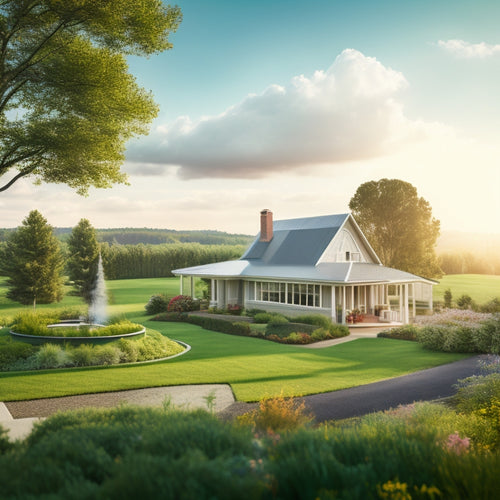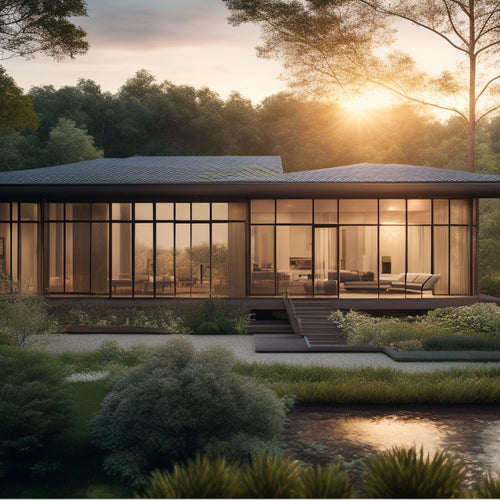
What Are the Best Water-Wise Garden Irrigation Methods?
Share
You can greatly reduce your water consumption by adopting efficient irrigation methods. Drip irrigation systems, which deliver water directly to plant roots, are a popular choice. Micro-irrigation techniques, including bubbler systems, also reduce evaporation and runoff. Soil moisture monitoring tools and smart watering sensors help determine plant water needs, while rainwater harvesting and grey water irrigation systems reduce reliance on municipal water. Weather-based irrigation controllers and automated watering schedules optimize water usage. By exploring these water-wise garden irrigation methods, you'll uncover the best approach for your specific needs, and access a wealth of knowledge to help you create a sustainable and thriving garden.
Key Takeaways
- Drip irrigation systems with targeted emitters and proper spacing reduce water waste and promote healthy plant growth.
- Micro-irrigation techniques, including bubbler systems, minimize evaporation and runoff, supplying water directly to plant roots.
- Soil moisture monitoring with advanced sensors and real-time data optimizes irrigation schedules and prevents overwatering.
- Smart watering technologies, such as smart sensors and weather-based irrigation controllers, ensure efficient water use and reduce waste.
- Rainwater harvesting and grey water irrigation systems conserve potable water and reduce environmental impact when implemented correctly.
Drip Irrigation Systems Explained
Efficiency takes center stage in water-wise gardening, and drip irrigation systems are a shining example of this principle in action.
You'll find various drip emitter types, including inline, online, and point-source emitters, each suited for specific plant needs. With the increasing focus on renewable energy sources, it's crucial to evaluate the energy efficiency of your drip irrigation system, as well.
When installing, make sure you follow proper tips, such as spacing emitters correctly and using filters to prevent clogging. Regular maintenance practices, like flushing the system, will keep it running efficiently.
Cost considerations include the initial investment and water savings over time. You can customize your system to fit your specific garden needs, regulating pressure and flow rates as needed.
With proper planning, you can pair your drip system with compatible plants and water sources, resulting in significant water efficiency and a reduced environmental impact.
Smart Watering Sensors Benefits
You'll get the most out of your smart watering sensors by leveraging their soil moisture monitoring capabilities, which guarantee your plants receive the right amount of water at the right time.
By integrating renewable energy sources, such as solar energy systems, into your irrigation system, you can reduce your reliance on non-renewable energy sources and minimize your carbon footprint.
These sensors also provide real-time water alerts, so you'll never overwater or underwater again.
Soil Moisture Monitoring
Soil moisture levels are the ultimate deciding factor in when and how much to water, making accurate monitoring an essential aspect of water-wise gardening.
By keeping track of soil moisture, you can optimize your watering schedule to reduce waste and guarantee your plants receive the right amount of water.
Integrating energy-efficient solutions, such as high-efficiency solar panels, can also reduce your carbon footprint and lower operating costs. This enables you to allocate more resources to maintaining a healthy and thriving garden.
-
Improved moisture retention: Soil sensors help you identify areas where water is being lost to evaporation reduction, allowing you to adjust your irrigation strategy accordingly.
-
Optimized watering schedules: With real-time soil moisture data, you can create a customized watering schedule that meets your plants' specific needs.
-
Reduced water waste: By only watering when necessary, you'll minimize excess water usage and lower your water bill.
- Healthier plants: Soil moisture monitoring helps you avoid overwatering, which can lead to root rot and other problems, guaranteeing your plants thrive.
Real-Time Water Alerts
Real-time water alerts take soil moisture monitoring to the next level by providing instant notifications when your plants need water.
With smart watering sensors, you'll receive alerts on your phone or email, ensuring you never overwater or underwater again.
Furthermore, by leveraging advanced irrigation technology, you can optimize energy efficiency, much like fast charging infrastructure does for electric vehicles.
Additionally, smart watering systems can reduce operational costs, similar to how commercial solar charging systems lower energy expenses.
These real-time notifications optimize your water usage and prevent waste.
By leveraging advanced irrigation technology, you'll enjoy greater control over your garden's hydration, even when you're not physically present.
This means you can tend to your garden on your own terms, without being tied to a rigid watering schedule.
With real-time water alerts, you'll experience the freedom to manage your garden's water needs with precision and confidence.
Rainwater Harvesting Methods
By incorporating rainwater harvesting methods into your water-wise garden irrigation strategy, you can considerably reduce your reliance on municipal water supplies.
This approach not only conserves water but also lowers your water bill. Additionally, reducing our reliance on fossil fuels and shifting to sustainable practices is essential for combating climate change and mitigating biodiversity loss energy independence and security.
-
Rain Barrel Systems: Install rain barrels under your downspouts to collect and store rainwater for later use.
-
Rooftop Collection: Fit your rooftop with a collection system to channel rainwater into storage tanks or barrels.
-
Ground-Level Catchments: Create shallow depressions in your garden to collect and filter rainwater for irrigation.
- Ponds or Lakes: If you have a larger property, consider building a pond or lake to collect and store rainwater for irrigation and other non-potable uses.
Soil Moisture Monitoring Tools
Accurate soil moisture monitoring is vital in water-wise garden irrigation, as it enables you to determine when your plants need water and how much they require.
You can achieve this by using soil moisture monitoring tools that measure the moisture levels in your soil. These tools take into account factors such as soil types and their moisture retention capabilities, allowing you to adjust your irrigation strategies accordingly.
Advanced sensor technology provides you with real-time data, helping you optimize your garden planning and guarantee drought resistance.
Weather-Based Irrigation Controllers
You'll get the most out of your weather-based irrigation controller by choosing one that incorporates smart sensors, which can detect subtle changes in your garden's microclimate.
Real-time weather data, typically sourced from online weather services or on-site weather stations, helps these controllers adjust watering schedules accordingly.
Smart Sensors Matter
Smart irrigation systems rely on smart sensors that monitor weather conditions to enhance water distribution.
These sensors guarantee you're not overwatering or underwatering your garden. By installing smart sensors, you'll reduce water waste and promote healthy plant growth.
Here are some benefits of using smart sensors in your irrigation system:
-
Accurate moisture monitoring: Smart sensors track soil moisture levels, adjusting irrigation schedules accordingly.
-
Customized watering: Sensors consider factors like soil type, plant species, and climate to deliver the right amount of water.
-
Improved moisture retention: Smart irrigation systems help maintain ideal soil moisture, reducing evaporation and runoff.
- Real-time monitoring: You can track your garden's water usage and receive alerts when adjustments are needed.
Real-Time Weather Data
Three key components make up a weather-based irrigation controller: a rain sensor, an ET (evapotranspiration) sensor, and a weather station.
You'll get real-time data on rainfall, temperature, humidity, and solar radiation. This information is used to calculate the exact amount of water your plants need, minimizing waste and reducing your climate impact.
The ET sensor measures the rate at which plants release water vapor, ensuring you're not overwatering. The weather station provides rainfall prediction, adjusting your irrigation schedule accordingly.
By using real-time weather data, you'll optimize your watering schedule, reducing waste and ensuring your plants receive the right amount of water.
This smart approach to irrigation gives you the freedom to enjoy a lush, healthy garden while conserving this precious resource.
Automated Watering Schedules
Weather-based irrigation controllers automate watering schedules by integrating real-time weather data, ensuring plants receive the perfect amount of water at the right time.
This means you can relax, knowing your garden is getting exactly what it needs, without wasting a single drop.
With automated timers and irrigation programming, you can:
- Schedule waterings based on temperature, humidity, and precipitation levels.
- Adjust watering frequencies according to plant type, soil moisture, and seasonal changes.
- Receive notifications when watering schedules need to be adjusted due to unexpected weather changes.
- Monitor and adjust your irrigation system remotely, giving you complete control over your garden's water usage.
Grey Water Irrigation Systems
Often, homeowners overlook a valuable resource in their water-wise irrigation efforts: grey water. This is the wastewater generated from sinks, showers, and washing machines. By utilizing grey water, you can greatly reduce your potable water consumption.
However, it's crucial to familiarize yourself with grey water regulations in your area, as they vary by region. You'll need to design a grey water storage system that meets local standards. Typically, this involves installing a separate storage tank and treatment system to guarantee the water is safe for irrigation.
With proper planning and installation, grey water irrigation systems can be an effective way to conserve water and reduce your environmental footprint.
Micro-Irrigation for Vegetable Gardens
When you're looking to optimize water usage in your vegetable garden, micro-irrigation is a highly effective approach.
You'll want to contemplate drip irrigation, which delivers water directly to the roots, reducing evaporation and runoff.
Drip Irrigation Benefits
By adopting drip irrigation, you can experience a significant reduction in water waste, with up to 50% less water used compared to traditional sprinkler systems.
This water-wise approach not only conserves this precious resource but also promotes healthy plant growth by supplying water directly to the roots.
Some of the key drip irrigation advantages include:
-
Increased crop yields: By providing plants with the right amount of water, you can expect higher yields and better quality crops.
-
Reduced evaporation: Water is supplied directly to the roots, minimizing evaporation and runoff.
-
Improved drip irrigation sustainability: This method reduces the environmental impact of irrigation, making it a more sustainable option.
- Less weed growth: With water only being supplied to the plants, you'll notice a significant reduction in weed growth.
Soaker Hose Efficiency
As an alternative to drip irrigation, soaker hoses offer a highly efficient micro-irrigation solution for vegetable gardens.
You can reap several soaker hose benefits, including reduced water evaporation and runoff. When installed correctly, soaker hoses deliver water directly to the soil, minimizing waste and guaranteeing your plants receive the right amount of moisture.
For a successful soaker hose installation, lay the hose along the vegetable rows, securing it with stakes or rocks. Be certain to check the hose's pressure rating and flow rate to ascertain it's suitable for your garden's size and layout.
With proper installation and maintenance, a soaker hose can be an advantageous asset in your water-wise gardening arsenal.
Sprinkler System Water Efficiency
You can greatly impact your water-wise garden's irrigation efficiency by optimizing your sprinkler system's water usage.
By making a few adjustments, you can notably reduce water waste and conserve this precious resource.
To improve sprinkler efficiency and promote water conservation, consider the following:
-
Install a rain sensor: This device automatically shuts off your sprinkler system during rainfall, preventing unnecessary water usage.
-
Use low-flow sprinkler heads: These heads reduce water flow rate, minimizing evaporation and runoff.
-
Divide your yard into zones: This allows you to tailor watering schedules to specific areas, ensuring each zone receives the right amount of water.
- Schedule watering during cooler hours: Watering during early morning or evening reduces evaporation and minimizes wind drift.
Bubbler Irrigation System Advantages
In addition to optimizing sprinkler systems, another water-wise garden irrigation method worth exploring is the bubbler irrigation system, which offers several advantages over traditional sprinkler systems when it comes to water efficiency and plant health. You'll find that bubbler systems provide better water distribution, reducing evaporation and runoff. They also promote healthy plant growth by supplying water directly to the roots, reducing foliage diseases.
| Advantage | Description | Benefit |
|---|---|---|
| Water Efficiency | Reduces evaporation and runoff | Saves water and lowers bills |
| Targeted Watering | Supplies water directly to roots | Promotes healthy plant growth |
| Disease Prevention | Reduces foliage diseases | Increases crop yields |
| Flexibility | Easy to install and maintain | Saves time and effort |
Subsurface Drip Irrigation Design
With its ability to deliver water directly to the roots of plants, subsurface drip irrigation design offers a highly efficient way to irrigate your garden, reducing evaporation and runoff while promoting healthy plant growth.
This approach increases irrigation efficiency by minimizing water loss and guaranteeing that plants receive exactly what they need.
To maximize the benefits of subsurface drip irrigation design:
- Properly space emitters: Confirm they're evenly distributed to prevent overlaps and gaps.
- Choose the right tubing: Select tubing that resists root intrusion and can withstand soil pressure.
- Monitor soil moisture: Regularly check soil moisture to adjust irrigation schedules as needed.
- Flush the system regularly: Remove debris and sediment to maintain ideal performance.
Frequently Asked Questions
Can I Install a Water-Wise Irrigation System Myself?
You can install a DIY irrigation system yourself, but make certain you've got the technical know-how and follow local regulations. Start by planning your system installation, choosing the right components, and testing it to guarantee efficient water distribution.
Are Water-Wise Irrigation Methods More Expensive Than Traditional Systems?
You're wise to wonder if water-wise irrigation methods break the bank. While upfront costs might be higher, you'll reap long-term savings through efficient water use and reduced utility bills, ultimately giving you the freedom to flourish in your garden.
How Often Should I Water My Plants During Extreme Heat?
During extreme heat, you'll want to water plants when soil moisture drops, avoiding plant stress. Check heat tolerance, and adjust your watering schedule to guarantee drought resilience; aim for irrigation efficiency, and you'll be liberating your plants from water woes.
Do Water-Wise Irrigation Methods Work for Large Gardens?
You can effectively implement water-wise irrigation methods in large gardens by using drip irrigation systems, which deliver water directly to roots, and supplementing with rainwater harvesting, reducing your water bill and environmental impact.
Are There Any Government Incentives for Water-Wise Irrigation Systems?
You'll find government incentives for water-wise irrigation systems, such as rebates and grants, which can greatly offset installation costs, allowing you to conserve water and save money without breaking the bank.
Related Posts
-

3 Ways Wind Power Boosts Home Value
Living near a wind farm can enhance your property's value in three significant ways. To begin with, proximity to wind...
-

7 Solar-Safe Window Solutions for Earth-Conscious Homeowners
As an earth-conscious homeowner, you're likely keen to find solar-safe window solutions that align with your values. ...
-

3 Earth-Loving Furniture Tips for Energy-Smart Homes
When furnishing your energy-smart home, you have the power to reduce your carbon footprint greatly by making consciou...


